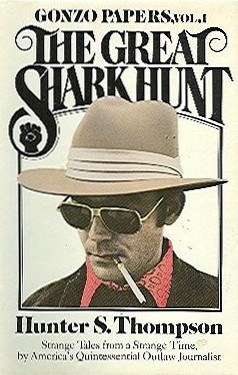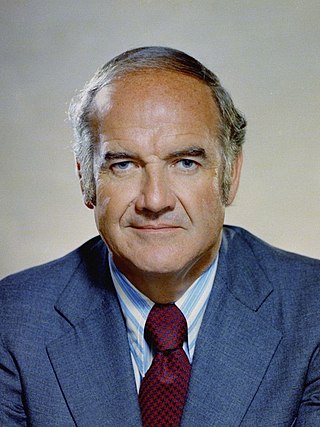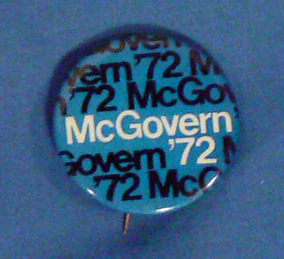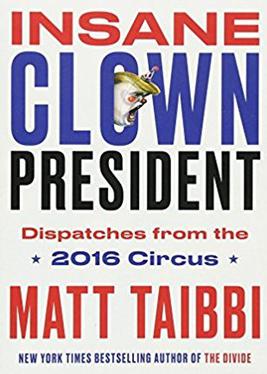
Hunter Stockton Thompson was an American journalist and author. He rose to prominence with the publication of Hell's Angels (1967), a book for which he spent a year living with the Hells Angels motorcycle club to write a first-hand account of their lives and experiences. In 1970, he wrote an unconventional article titled "The Kentucky Derby Is Decadent and Depraved" for Scanlan's Monthly, which further raised his profile as a countercultural figure. It also set him on the path to establishing his own subgenre of New Journalism that he called "Gonzo", a journalistic style in which the writer becomes a central figure and participant in the events of the narrative.

The 1968 United States presidential election was the 46th quadrennial presidential election, held on Tuesday, November 5, 1968. The Republican nominee, former vice president Richard Nixon, defeated both the Democratic nominee, incumbent vice president Hubert Humphrey, and the American Independent Party nominee, former Alabama governor George Wallace. This was the last election until 1988 in which the incumbent president was not on the ballot. This was also the last election where a third-party candidate received an electoral vote.

The 1972 United States presidential election was the 47th quadrennial presidential election held on Tuesday, November 7, 1972. Incumbent Republican president Richard Nixon defeated Democratic U.S. senator George McGovern in a historic-level landslide.

George Stanley McGovern was an American historian and South Dakota politician who was a U.S. representative and three-term U.S. senator, and the Democratic Party presidential nominee in the 1972 presidential election.

The Great Shark Hunt is a book by Hunter S. Thompson. Originally published in 1979 as Gonzo Papers, Vol. 1: The Great Shark Hunt: Strange Tales from a Strange Time, the book is a roughly 600-page collection of Thompson's essays from 1956 to the end of the 1970s, including the rise of the author's own gonzo journalism style as he moved from Air Force and sports beat writing to straight-ahead political commentary. It is the first of what would become four volumes in The Gonzo Papers series.

The 1972 Democratic National Convention was the presidential nominating convention of the Democratic Party for the 1972 presidential election. It was held at Miami Beach Convention Center in Miami Beach, Florida, also the host city of the Republican National Convention that year, on July 10–13 1972. Lawrence F. O'Brien served as permanent chairman of the convention, while Yvonne Braithwaite Burke served as vice-chair, becoming the first African American and the first woman of color to hold that position. On the last day of the convention, Lawrence F. O'Brien departed and Burke was left to preside for about fourteen hours.

The Boys on the Bus (1973) is author Timothy Crouse's seminal non-fiction book detailing life on the road for reporters covering the 1972 United States presidential election.
Pack journalism is the characterization of news reporting in which reporters from different news outlets collaborate to cover the same story, leaving news reporting homogeneous. This is the practice whereby reporters use the same sources of information for their stories. This not only refers to print sources but people who provide quotes and information for stories too. When reporters need to cover a specific person for a story, these individuals will often move from place to place, and crowd together in masses at the scenes of newsworthy locations just for comments and/or quotes from individuals involved. While this is considered proper reporting, when reporters from several news outlets take the same steps to cover the same story, it leaves news virtually unvaried.

The Canuck letter was a forged letter to the editor of the Manchester Union Leader, published February 24, 1972, two weeks before the New Hampshire primary of the 1972 United States presidential election. It implied that Senator Edmund Muskie, a candidate for the Democratic Party's presidential nomination, held prejudice against Americans of French-Canadian descent.

From January 24 to June 20, 1972, voters of the Democratic Party chose its nominee for president in the 1972 United States presidential election. Senator George McGovern of South Dakota was selected as the nominee through a series of primary elections, caucuses, and state party conventions, culminating in the 1972 Democratic National Convention held from July 10 to July 13, 1972, in Miami, Florida.

The 1972 United States presidential election in Massachusetts took place on November 7, 1972, as part of the 1972 United States presidential election, which was held throughout all 50 states and D.C. Voters chose 14 representatives, or electors to the Electoral College, who voted for president and vice president.

The 1968 presidential campaign of Hubert Humphrey began when Vice President of the United States Hubert Humphrey of Minnesota decided to seek the Democratic Party nomination for President of the United States following President Lyndon B. Johnson's announcement ending his own bid for the nomination. Johnson withdrew after an unexpectedly strong challenge from anti-Vietnam War presidential candidate, Senator Eugene McCarthy of Minnesota, in the early Democratic primaries. McCarthy, along with Senator Robert F. Kennedy of New York, became Humphrey's main opponents for the nomination. Their "new politics" contrasted with Humphrey's "old politics" as the increasingly unpopular Vietnam War intensified.

The George McGovern 1972 presidential campaign began when United States Senator George McGovern from South Dakota launched his second candidacy for the Presidency of the United States in an ultimately unsuccessful bid to win the 1972 presidential election against incumbent president Richard Nixon, winning only in the District of Columbia and the state of Massachusetts. McGovern vied to become the first South Dakota native to become president.
The expression "1000 percent" or "1000%" in a literal sense means one thousand in every hundred, and is used as a deliberate hyperbolism for effect. In American English it is used as a metaphor meaning very high emphasis, or enthusiastic support. It was used in the 1972 U.S. presidential election by presidential candidate George McGovern, who endorsed his running mate, Thomas Eagleton, "1000 percent" following a scandal, then soon after dropped him. Communication experts Judith Trent and Jimmy Trent agree with journalist Theodore H. White, who called it "possibly the most damaging single faux pas ever made by a presidential candidate".

This article lists those who were potential candidates for the Democratic nomination for Vice President of the United States in the 1972 election. Coming into the 1972 Democratic National Convention, South Dakota Senator George McGovern had the delegate lead, but did not have the presidential nomination locked up. After winning the Democratic nomination for president on July 13, McGovern looked for a running mate. McGovern's first choice for vice president was Ted Kennedy, but Kennedy refused to join the ticket; Minnesota Senator Walter Mondale, Wisconsin Senator Gaylord Nelson, and Connecticut Senator Abraham A. Ribicoff also declined. McGovern offered the position to Missouri Senator Thomas Eagleton, who appealed to labor groups and Catholics, two groups that McGovern had alienated during the primary campaign. The ticket of McGovern and Eagleton was nominated by the 1972 Democratic National Convention. Following the convention, it was revealed that Eagleton had received treatment for depression in the 1960s. Though McGovern considered keeping Eagleton on the ticket, he ultimately chose to replace Eagleton with former ambassador Sargent Shriver. The McGovern–Shriver ticket lost the presidential election to the Nixon–Agnew ticket. After the controversy surrounding Eagleton, future campaigns spent much more time vetting vice presidential candidates.

This article lists those who were potential candidates for the Democratic nomination for Vice President of the United States in the 1968 election. After winning the Democratic presidential nomination at the 1968 Democratic National Convention, incumbent Vice President Hubert Humphrey asked the convention to nominate Maine Senator Edmund Muskie as his running mate. The convention overwhelmingly voted to ratify the choice of Muskie, though Julian Bond picked up a scattering of votes. Muskie was surprised by the selection, as he was from a Northeastern state with few electoral votes. Humphrey almost chose Oklahoma Senator Fred R. Harris, but Humphrey decided that Muskie's age, governmental experience, and quiet temperament made him the better candidate. The Humphrey–Muskie ticket ultimately lost to the Nixon–Agnew ticket in the 1968 election. Muskie's place on the national ticket helped make him an early front-runner for the 1972 Democratic presidential nomination, though Muskie ultimately dropped out of the contest.

The 1972 United States presidential election in Texas was held on November 7, 1972, as part of the 1972 United States presidential election. Incumbent Republican President Richard Nixon overwhelmingly won the state of Texas with 66.20% of the vote, to the Democratic Party candidate George McGovern's 33.24%, thus giving him the state's 26 electoral votes. This result made Texas 9.8% more Republican than the nation-at-large. This was the first time a Republican won the state of Texas since Texas-born Dwight D. Eisenhower won it in 1956. Even as Democrat Dolph Briscoe won the gubernatorial election on the same Ballot.
Robert Skinner Boyd was an American journalist who spent most of his career working for the Knight Newspaper Group, spending two decades as the group's Washington bureau chief. He and Clark Hoyt won a Pulitzer Prize in 1973 for uncovering the fact that Senator Thomas Eagleton, George McGovern's choice for vice president, had had severe psychiatric problems and undergone three shock treatments. Instead of publishing their scoop, they disclosed their findings to McGovern's top advisor, and Eagleton withdrew as the Democratic nominee.

Insane Clown President: Dispatches from the 2016 Circus is a non-fiction book by Matt Taibbi about Donald Trump and the 2016 United States presidential election. The book contains illustrations by Rolling Stone artist Victor Juhasz. Taibbi's choice of title for the book was motivated by Trump's marketing style and is wordplay based on the name of American horrorcore band Insane Clown Posse. His work was inspired by Hunter S. Thompson, who had previously published Fear and Loathing on the Campaign Trail '72.
Together for McGovern was a political benefit concert held on June 14, 1972, produced by actor Warren Beatty to assist the 1972 presidential campaign of George McGovern, running as the anti-war candidate, against the Vietnam War. Also known as Together with McGovern and Stars for McGovern, the concert drew a crowd of 18,000 to 20,000 attendees at Madison Square Garden in New York City. For the concert, Beatty reunited the folk duo Simon & Garfunkel, the comedy team of Nichols and May, and the folk group Peter, Paul and Mary. Appearing solo was R&B and pop singer Dionne Warwick. A number of celebrities served as ushers, and McGovern gave a speech. The event reportedly raised $400,000.

















